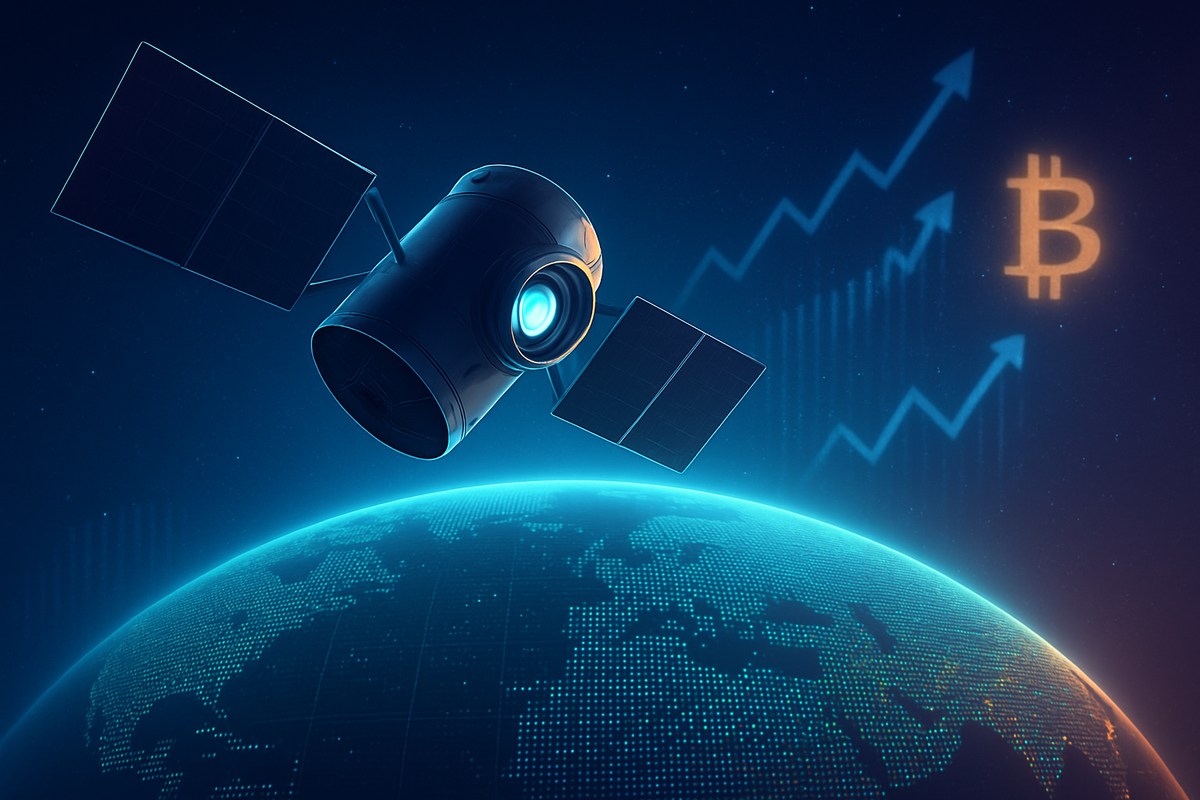Satellogic's Q3 Snapshot Reveals Strategic Push into AI-First Earth Observation

Satellogic Inc. (NASDAQ: SATL) has released its preliminary, unaudited financial results for the third quarter ended September 30, 2025, offering a crucial glimpse into its current financial health and strategic direction. With estimated Q3 revenue between $3.4 million and $3.8 million, and a cash position of approximately $28.3 million, the Nasdaq-listed firm is actively navigating the capital-intensive space technology sector. These figures, while modest, underscore the company's ongoing efforts to manage liquidity and fuel its ambitious plans, particularly the development of its NextGen satellite platform and AI-first constellations, which are poised to redefine investment and growth trends within the broader technology sector.
The immediate implications of these preliminary results are multifaceted. For Satellogic, the revenue figures indicate variability, yet the focus remains on long-term growth driven by technological innovation. The reported cash position, alongside recent stock issuance, highlights a continuous need for capital to support its expansive operational and developmental goals. For the wider technology sector, Satellogic's advancements in very-high-resolution Earth Observation (EO) and on-orbit AI processing signal a significant leap forward, pushing the boundaries of what's possible in geospatial intelligence and influencing the strategic directions of competitors and partners alike.
Detailed Coverage: Unpacking Satellogic's Strategic Moves
Satellogic's preliminary Q3 2025 revenue of $3.4 million to $3.8 million contributes to an estimated nine-month revenue of $11.2 million to $11.6 million, ending September 30, 2025. As of the same date, the company held approximately $28.3 million in cash, bolstered by $5.4 million in net proceeds from Class A common stock issuance during the quarter. These figures are preliminary and subject to change upon final audit, but they reflect a company actively managing its financial resources while investing heavily in future capabilities.
The period leading up to this announcement has been dynamic for Satellogic. In December 2024, the company formed a tasking partnership with Maxar Intelligence (NYSE: MAXR) for U.S. government missions and secured key approvals at its annual shareholders' meeting. Early 2025 saw a multi-year contract with Telespazio Brasil for the Brazilian Air Force and the open accessibility of its EarthView Dataset on Amazon Web Services (NASDAQ: AMZN). A significant milestone was the March 2025 announcement of its 2024 financial results, showcasing a 28% revenue increase to $12.9 million, selection by NASA for its Commercial SmallSat Data Acquisition Program, and a strategic move to U.S. jurisdiction. April 2025 brought a crucial $30 million multi-year contract for its AI-first constellation from an undisclosed defense and security customer. The company also announced its inclusion in the Russell 3000® Index in July 2025 and an exclusive seven-figure agreement with Suhora in India in September 2025. Most recently, on October 13, 2025, Satellogic confirmed the launch of its NextGen very high-resolution satellite platform, promising 30-centimeter class resolution and on-orbit AI-enabled analytics, with the first satellite expected to be operational by 2027.
Key players driving Satellogic's strategy include CEO Emiliano Kargieman, CFO Rick Dunn, and President Matthew Tirman. Their leadership has been instrumental in securing partnerships with entities like Maxar Intelligence (NYSE: MAXR), NASA, and the government of Malaysia. However, a notable period of insider selling in September 2025, particularly by CEO Kargieman, raised some investor concerns, leading to a temporary stock decline. Despite this, the market has shown mixed reactions, with periods of significant positive stock momentum, particularly following technological announcements, balanced by cautious sentiment regarding ongoing capital needs and insider trading. The announcement of a planned underwritten public offering on October 15, 2025, further underscores the continuous need for capital.
Market Ripple Effects: Winners and Losers in the Space Sector
Satellogic's strategic advancements, particularly its NextGen platform and AI-first constellations, are poised to create distinct winners and losers among public companies in the space technology sector. The company's focus on high-resolution, AI-driven, and non-ITAR compliant data solutions is sharpening the competitive edge and reshaping partnership dynamics.
Potential Losers: Competitors in the Earth observation imagery market, such as Planet Labs PBC (NYSE: PL) and BlackSky Technology Inc. (NYSE: BKSY), could face intensified pressure. Satellogic's NextGen platform, with its 30 cm-class resolution and integrated AI, directly competes with Planet's higher-resolution offerings and BlackSky's rapid revisit capabilities. Satellogic's emphasis on affordability, on-orbit AI analytics, and its non-ITAR design could lead to increased pricing pressure and force these companies to accelerate their own innovation and cost-reduction strategies to maintain market share, especially in government and defense sectors. The significant $30 million contract secured by Satellogic for its AI-first constellation demonstrates its ability to capture substantial defense and security business, a core market for BlackSky.
Potential Winners: On the other hand, companies that partner with or support Satellogic's ecosystem stand to benefit. Palantir Technologies (NYSE: PLTR), which partnered with Satellogic in 2022, could see expanded opportunities. As Satellogic generates increasingly sophisticated, near real-time geospatial data and insights from its AI-first constellations, there will be a greater need for advanced platforms like Palantir's to integrate, analyze, and derive actionable intelligence from this data. Public launch service providers, such as Rocket Lab (NASDAQ: RKLB), could also see increased demand. Satellogic's plans to expand its constellation with NextGen satellites signal a continued and potentially growing need for satellite deployment services, providing a stable revenue stream for specialized launch providers. A financially robust Satellogic, driven by new contracts and strategic platform deployments, becomes a more active and reliable customer in the launch market.
Broader Implications: Trends, Regulations, and Precedents
Satellogic's preliminary Q3 update and strategic advancements are deeply embedded within, and actively shaping, several transformative trends in the space technology sector. The company's embrace of a NextGen platform with 30-centimeter resolution and AI-first constellations aligns perfectly with the burgeoning demand for high-resolution imagery and real-time data analytics across industries from defense to environmental monitoring. This move further fuels the proliferation of small satellite constellations, a trend driven by reduced costs and miniaturization, positioning Satellogic as a key contributor to the expanding Low Earth Orbit (LEO) ecosystem. The integration of AI and Machine Learning (AI/ML) directly on-orbit is a significant step, addressing latency issues and pushing the industry towards more autonomous and efficient Earth observation.
The ripple effects of Satellogic's strategy are substantial. Competitors like Maxar Technologies (NYSE: MAXR), Planet Labs (NYSE: PL), and BlackSky Technology (NYSE: BKSY) will face heightened pressure to innovate and integrate AI into their own offerings to keep pace. The non-ITAR design of NextGen is particularly impactful, offering Satellogic a competitive advantage in securing contracts with international governments that seek independent space capabilities, potentially disrupting the market dominance of traditionally ITAR-bound firms. For partners, Satellogic's commitment to enabling "sovereign constellations" through technology and knowledge transfer fosters deeper collaborations, transforming the company into a technology enabler rather than solely a data provider.
These advancements also bring significant regulatory and policy implications. The increasing number of satellites, particularly mega-constellations, intensifies concerns about orbital debris and collision risks, necessitating more robust international regulatory frameworks. Spectrum allocation and interference management become critical challenges for regulators like the ITU. Furthermore, the collection and AI-driven processing of vast amounts of high-resolution, real-time data raise complex questions about data privacy, ownership, and national security, demanding evolving legal frameworks beyond the current Outer Space Treaty of 1967.
Historically, Satellogic's approach echoes past disruptive innovations. Similar to SpaceX's Starlink, which democratized internet access, Satellogic aims to make high-resolution Earth observation "accessible and affordable," potentially democratizing access to critical geospatial data. The miniaturization of satellites over the last two decades serves as a precedent for how technological advancements can disrupt established players and create new market opportunities. While some envision Satellogic as the "eBay" or "Stripe" of Earth observation, aggregating data and driving down costs, the cautionary tales of past constellation failures like Teledesic serve as a reminder of the significant financial and technical challenges inherent in such ambitious undertakings.
The Road Ahead: What Comes Next for Satellogic and the Market
In the short term (next 1-2 years), Satellogic's financial stability remains paramount. The preliminary Q3 2025 revenue, while indicating growth, is still modest for a company with such capital-intensive operations. The success of its planned underwritten public offering of Class A common stock, announced on October 15, 2025, and its ability to secure additional funding without excessive shareholder dilution, will be crucial. The company's pivot towards a U.S.-centric structure and the $30 million AI-first constellation contract are positive steps that could provide more stable revenue streams, particularly from government and defense sectors. The operational readiness of the first NextGen satellite by 2027 will be a significant milestone, validating its 30-centimeter resolution and on-orbit AI processing capabilities to attract further customer commitments.
Long-term possibilities (beyond 2 years) for Satellogic are intrinsically linked to the successful scaling of its NextGen constellation and achieving profitability. The broader space technology market is projected for substantial growth, with the satellite-based Earth Observation (EO) market expanding significantly. Satellogic's vertically integrated model, offering high-frequency, high-resolution imagery at competitive prices, positions it favorably. The "AI-first" approach and on-orbit processing of NextGen could be a significant differentiator, delivering actionable insights faster, particularly to government and defense clients. If the company can effectively scale and deliver on its promise of continuous global remapping, it stands to capture a substantial share of the commercial and governmental EO market, with the non-ITAR design further expanding its global addressable market.
Potential strategic pivots or adaptations required include prioritizing sustainable funding and cash management to reduce reliance on external capital, optimizing operational costs, and accelerating revenue generation. Consistent execution of its constellation build-out plan, avoiding past shortfalls in meeting deployment targets, is critical. A refined market focus, balancing government and commercial customers, and continued investment in advanced data analytics and value-added services will be essential to effectively monetize its data. Given the intense competition, strategic partnerships with launch providers, ground station operators, or data analytics firms could enhance capabilities and market reach.
Market opportunities include the growing demand for EO data across various sectors, the increasing integration of AI and cloud computing in space, rising government and defense spending, and the broader commercialization of space. Challenges, however, include intense competition from established players, high capital requirements leading to "going concern" risks, regulatory uncertainties, and the inherent execution risks associated with ambitious constellation deployments. Potential scenarios range from successful pivot and steady growth, where Satellogic becomes a leader in sovereign EO solutions, to incremental progress with continued financial pressure, or a pessimistic scenario of capital constraints and stalled growth, potentially leading to restructuring or acquisition.
Concluding Insights: A New Era for Earth Observation
Satellogic Inc.'s preliminary Q3 2025 financial update and its aggressive strategic push into NextGen and AI-first constellations mark a pivotal moment for the company and the Earth Observation sector. The key takeaway is a clear commitment to technological differentiation: by integrating AI directly on-orbit for near real-time analytics and offering 30-centimeter class resolution with a non-ITAR design, Satellogic is not merely upgrading its capabilities but fundamentally reshaping how geospatial intelligence is collected and delivered. This strategy aims to democratize access to high-quality, high-frequency data, making it more affordable and actionable for a diverse range of users, from environmental monitoring to national security.
Moving forward, the market is poised for a new era of geospatial intelligence, characterized by speed, precision, and autonomy. Satellogic's advancements set a new benchmark, compelling competitors to innovate rapidly or risk falling behind. The focus on sovereign capabilities and technology transfer also positions the company as a strategic partner for nations seeking independent space infrastructure, moving beyond a simple data provider model. The lasting impact could be a redefinition of industry standards, fostering a more dynamic and competitive landscape where on-orbit intelligence becomes the norm.
Investors should closely monitor several key indicators in the coming months, particularly given the current date of October 15, 2025. The release of complete, audited Q3 and full-year 2025 financial results will provide a definitive picture of the company's financial health and operational cash flow. The terms and outcome of the announced underwritten public offering of Class A common stock will be critical in assessing potential shareholder dilution and the company's ability to secure necessary capital. Furthermore, tangible progress on NextGen satellite production and deployment, along with additional customer commitments and the realization of revenue from these next-generation capabilities, will be crucial. Finally, consistent execution of international contracts, sustained operational efficiency, and the company's trajectory towards profitability will be vital signs of its long-term viability and potential to carve out a leading position in the burgeoning space technology market.
This content is intended for informational purposes only and is not financial advice
More News
View More




Recent Quotes
View More
Quotes delayed at least 20 minutes.
By accessing this page, you agree to the Privacy Policy and Terms Of Service.